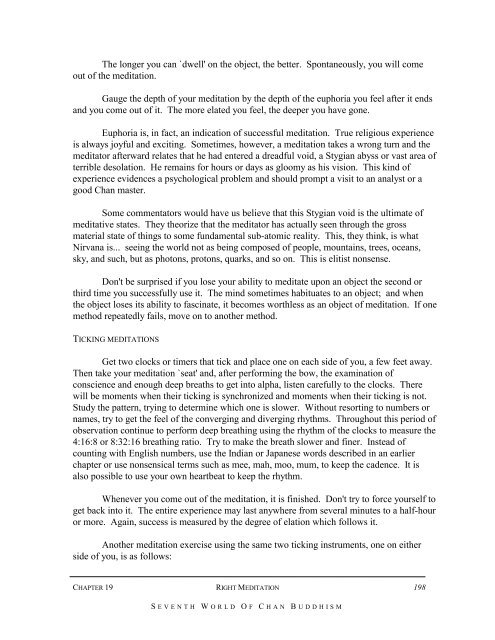seventh world of chan buddhism - Zen Buddhist Order of Hsu Yun
seventh world of chan buddhism - Zen Buddhist Order of Hsu Yun
seventh world of chan buddhism - Zen Buddhist Order of Hsu Yun
You also want an ePaper? Increase the reach of your titles
YUMPU automatically turns print PDFs into web optimized ePapers that Google loves.
The longer you can `dwell' on the object, the better. Spontaneously, you will come<br />
out <strong>of</strong> the meditation.<br />
Gauge the depth <strong>of</strong> your meditation by the depth <strong>of</strong> the euphoria you feel after it ends<br />
and you come out <strong>of</strong> it. The more elated you feel, the deeper you have gone.<br />
Euphoria is, in fact, an indication <strong>of</strong> successful meditation. True religious experience<br />
is always joyful and exciting. Sometimes, however, a meditation takes a wrong turn and the<br />
meditator afterward relates that he had entered a dreadful void, a Stygian abyss or vast area <strong>of</strong><br />
terrible desolation. He remains for hours or days as gloomy as his vision. This kind <strong>of</strong><br />
experience evidences a psychological problem and should prompt a visit to an analyst or a<br />
good Chan master.<br />
Some commentators would have us believe that this Stygian void is the ultimate <strong>of</strong><br />
meditative states. They theorize that the meditator has actually seen through the gross<br />
material state <strong>of</strong> things to some fundamental sub-atomic reality. This, they think, is what<br />
Nirvana is... seeing the <strong>world</strong> not as being composed <strong>of</strong> people, mountains, trees, oceans,<br />
sky, and such, but as photons, protons, quarks, and so on. This is elitist nonsense.<br />
Don't be surprised if you lose your ability to meditate upon an object the second or<br />
third time you successfully use it. The mind sometimes habituates to an object; and when<br />
the object loses its ability to fascinate, it becomes worthless as an object <strong>of</strong> meditation. If one<br />
method repeatedly fails, move on to another method.<br />
TICKING MEDITATIONS<br />
Get two clocks or timers that tick and place one on each side <strong>of</strong> you, a few feet away.<br />
Then take your meditation `seat' and, after performing the bow, the examination <strong>of</strong><br />
conscience and enough deep breaths to get into alpha, listen carefully to the clocks. There<br />
will be moments when their ticking is synchronized and moments when their ticking is not.<br />
Study the pattern, trying to determine which one is slower. Without resorting to numbers or<br />
names, try to get the feel <strong>of</strong> the converging and diverging rhythms. Throughout this period <strong>of</strong><br />
observation continue to perform deep breathing using the rhythm <strong>of</strong> the clocks to measure the<br />
4:16:8 or 8:32:16 breathing ratio. Try to make the breath slower and finer. Instead <strong>of</strong><br />
counting with English numbers, use the Indian or Japanese words described in an earlier<br />
chapter or use nonsensical terms such as mee, mah, moo, mum, to keep the cadence. It is<br />
also possible to use your own heartbeat to keep the rhythm.<br />
Whenever you come out <strong>of</strong> the meditation, it is finished. Don't try to force yourself to<br />
get back into it. The entire experience may last anywhere from several minutes to a half-hour<br />
or more. Again, success is measured by the degree <strong>of</strong> elation which follows it.<br />
Another meditation exercise using the same two ticking instruments, one on either<br />
side <strong>of</strong> you, is as follows:<br />
CHAPTER 19 RIGHT MEDITATION<br />
S EVENTH W ORLD O F C HAN B UDDHISM<br />
198


